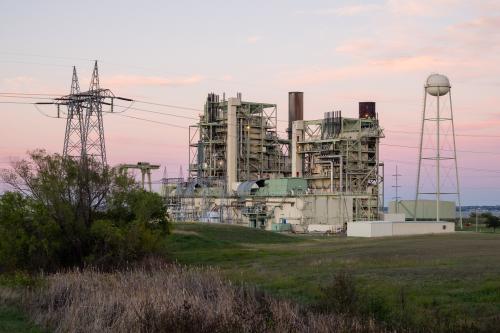In an era of political tribalism, infrastructure investment is one of the few areas of American public policy that polls well among everyone. Which makes sense; who doesn’t like the idea of filling potholes, new airport terminals, and water systems that don’t burst?
The challenge is keeping up with the country’s enormous investment needs, whether it’s maintaining what we’ve already built, integrating new digital technologies, or adding capacity in growing regions. State and local governments—who are responsible for managing our public assets—continue to spend larger amounts, but there is always more to do.
One of the most promising innovations to emerge over the past decade is greater use of public-private partnerships (P3s) to complement traditional funding. When designed well, collaborating with the private sector can attract greater net investment, unlock new management efficiencies, and strike an ideal balance between protecting the public interest and generating private return on investment. Yet not all collaborations are designed well, and there is a growing recognition that it is often state and local governments who are not yet ready to tap these new approaches.
Within this context, the Brookings Metropolitan Policy Program and the National Association of Counties hosted “Collaborate to Build: Modernizing Infrastructure Policies to Advance Public-Private Partnerships” during Infrastructure Week 2018. Bringing together panelists with public and private expertise, the resulting conversation stressed many of the areas where outmoded and outdated public policies restrict the promise of new P3 models. While the topics dove into a wealth of different subjects, there were three common areas where improved public policy has the power to unlock P3’s potential.
Asset management
For state and local governments, it’s often what they don’t know that stops them. In this case, there is little clarity about exactly what assets they own, where they’re located, what their value is, or their physical quality. This is especially the case in the water sector—where many older cities, in particular, don’t even know the type of pipes they manage—but it exists for everything from real estate holdings to transportation assets.
The response is to mandate asset inventories and life-cycle asset management plans. Some of this extends directly from within local government, such as the Washington, D.C.’s comprehensive asset inventory receiving national attention. In other cases, it’s coming from federal requirements. The Federal Transit Administration finalized a rule in July 2016 that requires transit agencies to develop transit asset management plans, including asset inventories, state-of-good-repair standards, and a prioritized list of investments (and report this data to the National Transit Database). The Federal Highway Administration finalized a similar rule in October 2016 that requires states receiving federal formula grant funding for transportation to develop transportation asset management plans for all National Highway System pavement and bridges.
The foundation of sound infrastructure management is understanding your assets, meaning such advanced asset plans are essential. It’s also a policy model that applies to every public portion of the built environment: transportation, water, aviation, broadband, schools, civic buildings, vacant land, and underused real estate.
Staffing capacity
It’s easy to think of infrastructure as project-driven, but workforce components are equally essential, from maximizing labor impacts via public investment to training the next generation of infrastructure workers. P3s are no different, and public sector staffing capacity remains an enduring challenge in the successful implementation of P3s. Two areas of capacity building stand out: contractual expertise and technical expertise beyond traditional core competencies.
Private investors often have savvy full-time staff with deep expertise in complex P3 contracts, but rarely is there equivalent public staff capacity to broker the right deals from the perspective of public good. Public sector organizations dedicated to P3s offer a solution, where the sole purpose is to foster collaboration and fill the capacity void. It is important to recognize, however, that this might be financially infeasible for smaller local governments. This is why federalist collaboration—including statewide expertise and USDOT’s Build America Bureau—are critical.
In terms of technical expertise, the mantra in resource-constrained public agencies is to focus on core competencies, but this can leave them with limited know-how in newer, more innovative technologies. For example, water departments have significant experience in traditional water infrastructure like pipes, but might struggle to understand emerging green infrastructure techniques that can manage stormwater without pipes and concrete. This also ties into procurement, where it is hard to create an innovative statement of work during a Request for Proposal (RFP) process when there is a lack of understanding of the benefits and drawbacks of new techniques and technologies.
Political risk and information sharing
The overlay of short-term election cycles on long-term infrastructure projects can lead to misaligned incentives. Even for communities where innovative public agencies are interested in pursuing alternative financing or new technologies, the reputational risk to elected officials in putting forth a different strategy can stifle innovation. The reluctance to assume this risk from the private sector perspective only adds to the problem.
While there is real political risk in advocating for a financing scheme relatively untested in the U.S., there are also opportunities for bipartisanship. Additionally, local leaders interested in P3s can look to best practices developed overseas and other models nationwide. There’s a wealth of information on successful deals, tactics to avoid, and new partnerships tested in U.S. cities.
At the same time, states and localities that do forge successful partnerships have a responsibility to share information on what works and what doesn’t–from which entity has control over policy decisions, to public transparency, and RFPs. Since P3s are relatively new in the U.S., case studies that draw attention to best (and worst) practices are incredibly useful to educate other governments. Early adopters will act as petri dishes of innovation for later adopters to learn from and copy.
There is much to be done to modernize infrastructure policy for public-private collaboration. It is important to remember, though, that infrastructure is not an end, but a means to an end. The end here is public good–and P3s can have the potential to enhance public good with better asset management, improved staff capacity, and mitigated political risk.
The Brookings Institution is committed to quality, independence, and impact.
We are supported by a diverse array of funders. In line with our values and policies, each Brookings publication represents the sole views of its author(s).









Commentary
Modernizing infrastructure policies to advance public-private partnerships
May 22, 2018